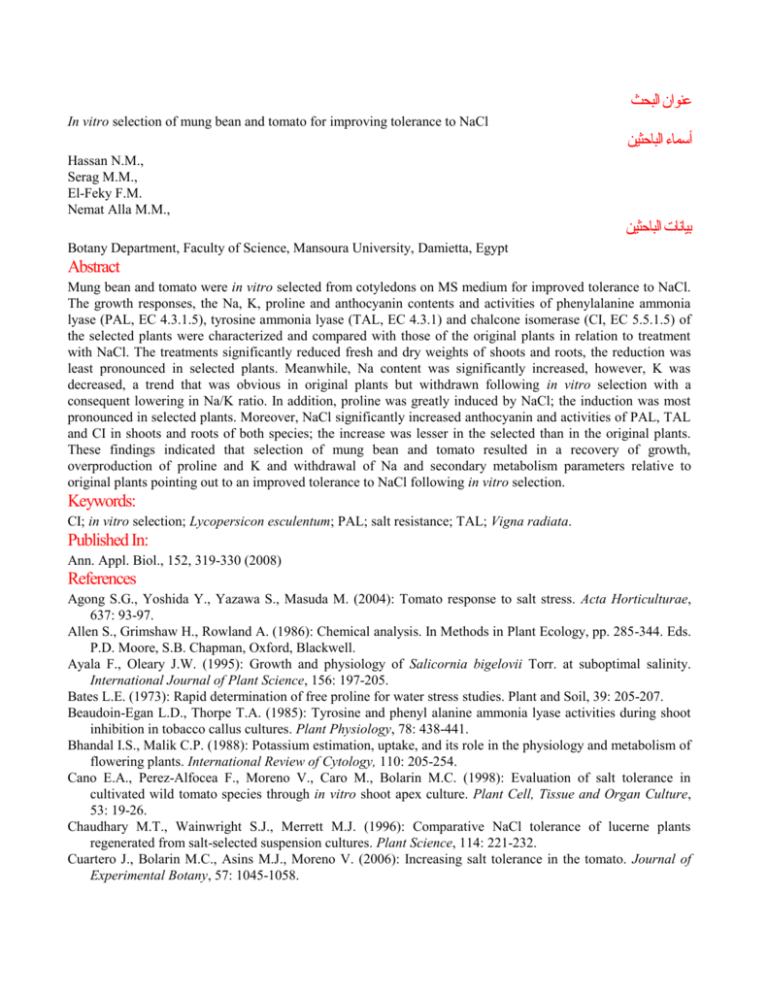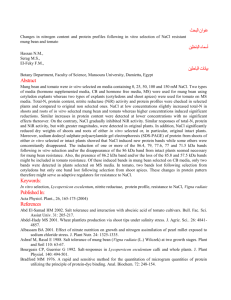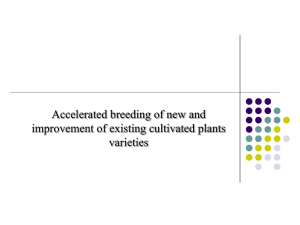1 -
advertisement

عنوان البحث In vitro selection of mung bean and tomato for improving tolerance to NaCl أسماء الباحثين Hassan N.M., Serag M.M., El-Feky F.M. Nemat Alla M.M., بيانات الباحثين Botany Department, Faculty of Science, Mansoura University, Damietta, Egypt Abstract Mung bean and tomato were in vitro selected from cotyledons on MS medium for improved tolerance to NaCl. The growth responses, the Na, K, proline and anthocyanin contents and activities of phenylalanine ammonia lyase (PAL, EC 4.3.1.5), tyrosine ammonia lyase (TAL, EC 4.3.1) and chalcone isomerase (CI, EC 5.5.1.5) of the selected plants were characterized and compared with those of the original plants in relation to treatment with NaCl. The treatments significantly reduced fresh and dry weights of shoots and roots, the reduction was least pronounced in selected plants. Meanwhile, Na content was significantly increased, however, K was decreased, a trend that was obvious in original plants but withdrawn following in vitro selection with a consequent lowering in Na/K ratio. In addition, proline was greatly induced by NaCl; the induction was most pronounced in selected plants. Moreover, NaCl significantly increased anthocyanin and activities of PAL, TAL and CI in shoots and roots of both species; the increase was lesser in the selected than in the original plants. These findings indicated that selection of mung bean and tomato resulted in a recovery of growth, overproduction of proline and K and withdrawal of Na and secondary metabolism parameters relative to original plants pointing out to an improved tolerance to NaCl following in vitro selection. Keywords: CI; in vitro selection; Lycopersicon esculentum; PAL; salt resistance; TAL; Vigna radiata. Published In: Ann. Appl. Biol., 152, 319-330 (2008) References Agong S.G., Yoshida Y., Yazawa S., Masuda M. (2004): Tomato response to salt stress. Acta Horticulturae, 637: 93-97. Allen S., Grimshaw H., Rowland A. (1986): Chemical analysis. In Methods in Plant Ecology, pp. 285-344. Eds. P.D. Moore, S.B. Chapman, Oxford, Blackwell. Ayala F., Oleary J.W. (1995): Growth and physiology of Salicornia bigelovii Torr. at suboptimal salinity. International Journal of Plant Science, 156: 197-205. Bates L.E. (1973): Rapid determination of free proline for water stress studies. Plant and Soil, 39: 205-207. Beaudoin-Egan L.D., Thorpe T.A. (1985): Tyrosine and phenyl alanine ammonia lyase activities during shoot inhibition in tobacco callus cultures. Plant Physiology, 78: 438-441. Bhandal I.S., Malik C.P. (1988): Potassium estimation, uptake, and its role in the physiology and metabolism of flowering plants. International Review of Cytology, 110: 205-254. Cano E.A., Perez-Alfocea F., Moreno V., Caro M., Bolarin M.C. (1998): Evaluation of salt tolerance in cultivated wild tomato species through in vitro shoot apex culture. Plant Cell, Tissue and Organ Culture, 53: 19-26. Chaudhary M.T., Wainwright S.J., Merrett M.J. (1996): Comparative NaCl tolerance of lucerne plants regenerated from salt-selected suspension cultures. Plant Science, 114: 221-232. Cuartero J., Bolarin M.C., Asins M.J., Moreno V. (2006): Increasing salt tolerance in the tomato. Journal of Experimental Botany, 57: 1045-1058. Di Caterina R., Giuliani M.M., Rotunno T., De Caro A., Flagella Z. (2007): Influence of salt stress on seed yield and oil quality of two sunflower hybrids. Annals of Applied Biology, 151: 145–154. Dorey S., Kopp M., Geoffroy P., Fritig B., Kaufmann S. (1999): Hydrogen peroxide from the oxidative burst is neither necessary nor sufficient for hypersensitive cell death induction. Phenylalanine ammonia lyase stimulation, salicylic acid accumulation or scopoletin consumption in cultured tobacco cells treated with elicitin. Plant Physiology, 121: 163-172. Eraslan F., Inal A., Savasturk O., Gunes A. (2007): Changes in antioxidative system and membrane damage of lettuce in response to salinity and boron toxicity. Scientia Horticulturae, 114: 5–10. Faisal M., Ahmad N., Anis M. (2005): Shoot multiplication in Rauvolfia tetraphylla L. using thidiazuron. Plant Cell Tissue and Organ Culture, 80: 187–190. Flowers T.J. (2004): Improving crop salt tolerance. Journal of Experimental Botany, 55: 307-319. Ghars M.A., Parre E., Debeza A., Bordenave M., Luc R., Laurent L., Alain B., Arnould S., Chedly A. (2008): Comparative salt tolerance analysis between Arabidopsis thaliana and Thellungiella halophila, with special emphasis on K+/Na+ selectivity and proline accumulation. Journal of Plant Physiology, In Press. Gorai M., Neffati M. (2007): Germination responses of Reaumuria vermiculata to salinity and temperature. Annals of Applied Biology, 151: 53–59. Gulati A., Jaiwal P.K. (1996): Effect of NaCl on nitrate reductase, glutamate dehydrogenase and glutamate synthase in Vigna radiata calli. Biologia Plantarum, 38: 177-183. Hahlbrock K., Wong E., Schill L., Grisebach H. (1970): Comparison of chalcone-flavonone isomerase heteroenzymes and isoenzymes. Phytochemistry, 9: 949-958. Hassan N.M., Serag M.S., Momtaz O.A., El-Feky F.M. (2003): In vitro selection of NaCl resistant mung bean and tomato plants. Egyptian Journal of Agronomy, 25: 25-43. Hassan N.M., Serag M.S., El-Feky F.M. (2004): Changes in nitrogen content and protein profiles following in vitro selection of NaCl resistant mung bean and tomato. Acta Physiologiae Plantarum, 26: 165-175. Hoagland R. (1980): Effect of glyphosate on metabolism of phenolic compounds, VI. Effect of glyphosine and glyphosate metabolites on phenylalanine ammonia lyase activity, growth and protein, chlorophyll and anthocyanin level in soybean (Glycine max) seedlings. Weed Science, 28: 393-400. Hoagland R., Duke S.O. (1981): Effect of herbicides on extractable phenylalanine ammonia-lyase activity in light-and dark-grown soybean (Glycine max) seedlings. Weed Science, 29: 433-439. Iler S.E., Swanton C.J., Pauls K. (1993): In vitro selection of Imazethapyr-tolerant tomato (Lycopersicon esculentum mill). Weed Science, 41: 12-17. Jiang M., Zhang J. (2002): Water stress-induced abscisic acid accumulation triggers the increased generation of reactive oxygen species and up-regulates the activities of antioxidant enzymes in maize leaves. Journal of Experimental Botany, 53: 2401-2410. Jez J.M., Bowman M.E., Dixon R.A., Noel J.P. (2000): Structure and mechanism of the evolutionarily unique plant enzyme chalcone isomerase. Natural Structure of Biology, 7: 786-791. Martinez C.A., Maestri M., Lani E.G. (1996): In vitro salt tolerance and proline accumulation in Andean potato (Solanum spp.) differing in frost resistance. Plant Science, 116: 177-184. Mehta N., Bharti S., Datta K.S. (1993): Effect of chloride and sulphate salinities on the concentration of some important metabolites in chickpea. Haryana Agricuture University Journal Researches, 23: 150-155. Mohan Jain S. (2001): Tissue culture-derived variation in crop improvement. Euphytica, 118: 153-166. Mozafer A., Dertli J.J. (1990): Multiple effects of salinity stress and temperature shock on growth of Barley. Plant Soil, 128: 153-16. Murillo-Amador B., Jones H.G., Kaya C., Lopez R.A., Garcia-Hernandez J.L., Troyo-Dieguez E., AvilaSerrano N.Y., Rueda-Puente E. (2006a): Effects of foliar application of calcium nitrate on growth and physiological attributes of cowpea (Vigna unguiculata L. Walp.) grown under salt stress. Environmental and Experimental Botany, 58: 188-196. Murillo-Amador B., Troyo-Dieguez E., Garcia-Hernandez J.L., Lopez R.A., Avila-Serrano N.Y., ZamoraSalgado S.,Rueda-Puente E. Kaya C. (2006b): Effect of NaCl salinity in the genotypic variation of cowpea (Vigna unguiculata) during early vegetative growth. Scientia Horticulturae, 108: 423-431. Murillo-Amador B., Yamada S., Yamaguchi T., Rueda-Puente E., Avila-Serrano N., Garcia-Hernandez J.L., Lopez-Aguilar R., Troyo-Dieguez E., Nieto-Garibay A. (2007): Influence of calcium silicate on growth, physiological parameters and mineral nutrition in two legume species under salt stress. Journal of Agronomy and Crop Science, 193: 413-421. Nandwal A.S., Kukreja S., Kumar N., Sharma P.K., Jain M., Mann A., Singh S. (2007): Plant water status, ethylene evolution, N2-fixing efficiency, antioxidant activity and lipid peroxidation in Cicer arietinum L. nodules as affected by short-term salinization and desalinization. Journal of Plant Physiology, 164: 11611169. Nemat Alla M.M., Younis M.E. (1995): Herbicide effects on phenolic metabolism in maize (Zea mays L.) and soybean (Glycine max L.) seedlings. Journal of Experimental Botany, 46: 1731-1736. Nemat Alla M.M., Younis M.E., El-Shihaby O.A., El-Bastawisi Z.M. (2002): Kinetin regulation of growth and secondary treated Vigna sinensis and Zea mays. Acta Physiologiae Plantarum, 24: 19-27. Pareek L.K. (2005): Trends in plant tissue culture and biotechnology, Jodhpur, Agrobios. Pattnaik J., Debata B.K. (1997): In vitro selection of NaCl tolerant callus lines of Cymbopogon martinii (Roxb.) Wats. Plant Science, 124: 203-210. Prado F.E., Boero C., Gallardo M., Gonzalez G.A. (2000): Effect of NaCl on germination, growth, and soluble sugar content in Chenopodium quinoa willd. Seeds. Botanical Bulletin of Academic Science, 41: 27-34. Rout G.R. (2002): Direct plant regeneration from leaf explants of Plambago species and its genetic fidelity through RAPD markers. Annals of Applied Biology, 140: 305–313. Samaras Y., Bressan R.A., Csonka L.N., Gracia-Rios M.G., Paino D`Urzo M., Rhodes D. (1995): Proline accumulation during drought and salinity. In Environment and Plant Metabolism: Flexibility and Accumulation, pp. 161-187. Ed. N Smirnoff, BIOS Scientific Publishers, Oxford, UK. Silva-Ortega C.O., Ochoa-Alfaro A.E., Reyes-Agüero J.A., Aguado-Santacruz G.A., Jimenez-Bremont J.F. (2008): Salt stress increases the expression of P5CS gene and induces proline accumulation in cactus pear. Plant Physiology and Biochemistry, 46: 82-92. Snedecor W., Cochran G. (1980): Statistical methods. 7th edn. The Iowa State Univ. Press, Ames, Iowa. Tester M., Davenport R. (2003): Na+ tolerance and Na+ transport in higher plants. Annals of Botany, 91: 503527. Tuna A.L., Kaya C., Higgs D., Murillo-Amador B., Aydemir S., Girgin A.R. (2008): Silicon improves salinity tolerance in wheat plants. Environmental and Experimental Botany, 62: 10-16. Wang Z., Yuan Y., Ou J., Lin Q., Zhang C. (2007): Glutamine synthetase and glutamate dehydrogenase contribute differentially to proline accumulation in leaves of wheat (Triticum aestivum) seedlings exposed to different salinity. Journal of Plant Physiology, 164: 695-701. Yazici I., Turkan I., Sekmen A.H., Demiral T. (2007): Salinity tolerance of purslane (Portulaca oleracea L.) is achieved by enhanced antioxidative system, lower level of lipid peroxidation and proline accumulation. Environmental and Experimental Botany, 61: 49–57. Younis M.E., El-Shihaby O.A., Nemat Alla M.M., El-Bastawisy Z.M. (2003): Kinetin alleviates the influence of water logging and salinity on growth and affects the production of plant growth regulators in Vigna sinensis and Zea mays. Agronomie, 23: 277-285.








